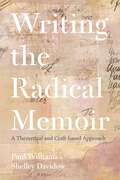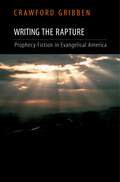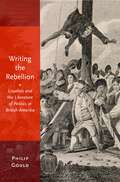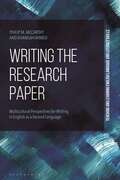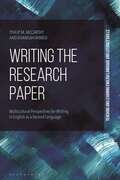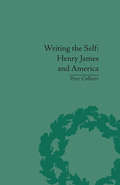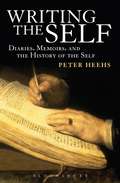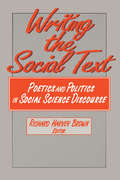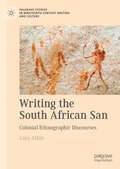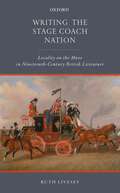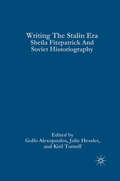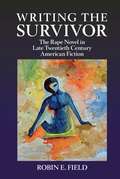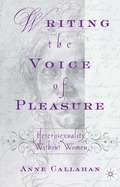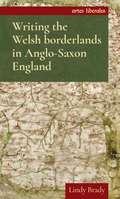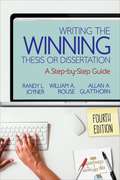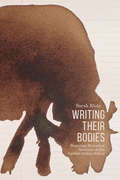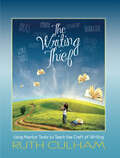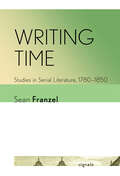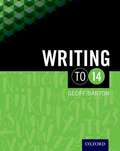- Table View
- List View
Writing the Radical Memoir: A Theoretical and Craft-based Approach
by Paul Williams Shelley DavidowFor those that have mastered the basics of memoir and wish to probe this brand of creative nonfiction further, Writing the Radical Memoir uses salient theories about memory and the self to challenge assumptions about how we remember and tell the truth of our lives when we write about it. Innovative in approach and making new critical ideas accessible, each chapter maps out the key principles of such writers as Barthes, Lacan, Derrida, Lewis Mehl-Madrona, Philippe Le Jeune and Joseph Campbell, invokes literary examples to show how other writers have mastered the idea before reflecting on how you can practically apply the theory to your writing. With original exercises and prompts for further reading that bridge the gap between the theoretical and how it might be put into practice, the book is attentive to the multiple facets of the genre of nonfiction writing generally, covering such topics as: - The writer/ reader contract- How to embark on a thematic/ symbolic exploration of themes and incidents in your life- How neuro-scientific theory can inform our understanding of memory and recall and what happens to our memories when we remember them- Character development and the ethics of writing about real people- How constructing your identity in memoir offers a chance to push back against traditional structures- That memoir might not be preservation of your past but a process of self-erasure- How J. M. Coetzee's Autrebiography trilogy challenges traditional biographyBy bringing together lived experience, post-structuralist and postmodernist theories, praxis and artistic vision as a unique approach to writing memoir, this book encourages you to think the self, how it is portrayed, created, erased and made strange through the process of writing and remembering.
Writing the Rapture: Prophecy Fiction in Evangelical America
by Crawford GribbenFor the past twenty years, evangelical prophecy novels have been a powerful presence on American bestseller lists. Emerging from a growing conservative culture industry, the genre dramatizes events that many believers expect to occur at the end of the age - the rapture of the saved, the rise of the Antichrist, and the fearful tribulation faced by those who are "left behind." Seeking the forces that drove the unexpected success of the Left Behind novels, Crawford Gribben traces the gradual development of the prophecy fiction genre from its eclectic roots among early twentieth-century fundamentalists. The first rapture novels came onto the scene at the high water mark of Protestant America. From there, the genre would both witness the defeat of conservative Protestantism and participate in its eventual reconstruction and return, providing for the renaissance of the evangelical imagination that would culminate in the Left Behind novels. Yet, as Gribben shows, the rapture genre, while vividly expressing some prototypically American themes, also serves to greatly complicate the idea of American modernity-assaulting some of its most cherished tenets. Gribben concludes with a look at "post-Left Behind" rapture fiction, noting some works that were written specifically to counter the claims of the best-selling series. Along the way, he gives attention not just to literary fictions, but to rapture films and apocalyptic themes in Christian music. Writing the Rapture is an indispensable guide to this flourishing yet little understood body of literature.
Writing the Rebellion: Loyalists and the Literature of Politics in British America (Oxford Studies in American Literary History)
by Philip GouldWriting the Rebellion presents a cultural history of loyalist writing in early America. There has been a spate of related works recently, but Philip Gould's narrative offers a completely different view of the loyalist/patriot contentions than appears in any of these accounts. By focusing on the literary projections of the loyalist cause, Gould dissolves the old legend that loyalists were more British than American, and patriots the embodiment of a new sensibility drawn from their American situation and upbringing. He shows that both sides claimed to be heritors of British civil discourse, Old World learning, and the genius of English culture. The first half of Writing Rebellion deals with the ways "political disputation spilled into arguments about style, form, and aesthetics, as though these subjects could secure (or ruin) the very status of political authorship." Chapters in this section illustrate how loyalists attack patriot rhetoric by invoking British satires of an inflated Whig style by Alexander Pope and Jonathan Swift. Another chapter turns to Loyalist critiques of Congressional language and especially the Continental Association, which was responsible for radical and increasingly violent measures against the Loyalists. The second half of Gould's book looks at satiric adaptations of the ancient ballad tradition to see what happens when patriots and loyalists interpret and adapt the same text (or texts) for distinctive yet related purposes. The last two chapters look at the Loyalist response to Thomas Paine's Common Sense and the ways the concept of the author became defined in early America. Throughout the manuscript, Gould acknowledges the purchase English literary culture continued to have in revolutionary America, even among revolutionaries.
Writing the Research Paper: Multicultural Perspectives for Writing in English as a Second Language (Teaching and Learning English Language and Literacy Skills)
by Philip M. McCarthy Khawlah AhmedCovering both theoretical and practical approaches, Writing the Research Paper guides students studying in English as a second or additional language through the skills necessary for success in university-level writing and research. The book begins with theoretical considerations, such as research, argumentation and critical thinking. It then offers a broad range of practical assistance covering all aspects of the writing process, including topic selection, argument, counter-argument, paragraph structure and cohesion. The book is accompanied by a companion website, writingtheresearchpaper.com. The website hosts many features, including chapter summaries, exercises, quizzes, PowerPoints, additional learning material, and technology assistance. The website also hosts numerous authentic examples of student papers at each of the critical stages of the writing process.
Writing the Research Paper: Multicultural Perspectives for Writing in English as a Second Language (Teaching and Learning English Language and Literacy Skills)
by Philip M. McCarthy Khawlah AhmedCovering both theoretical and practical approaches, Writing the Research Paper guides students studying in English as a second or additional language through the skills necessary for success in university-level writing and research. The book begins with theoretical considerations, such as research, argumentation and critical thinking. It then offers a broad range of practical assistance covering all aspects of the writing process, including topic selection, argument, counter-argument, paragraph structure and cohesion. The book is accompanied by a companion website, writingtheresearchpaper.com. The website hosts many features, including chapter summaries, exercises, quizzes, PowerPoints, additional learning material, and technology assistance. The website also hosts numerous authentic examples of student papers at each of the critical stages of the writing process.
Writing the Self: Henry James and America
by Peter CollisterA monograph that re-evaluates the final decade of Henry James' creative life. It examines the narrative of "The American Scene", the autobiographical writing, a number of short stories and two incomplete novels: works which offer contrasting notations of the self.
Writing the Self: Henry James and America
by Peter CollisterA monograph that re-evaluates the final decade of Henry James' creative life. It examines the narrative of "The American Scene", the autobiographical writing, a number of short stories and two incomplete novels: works which offer contrasting notations of the self.
Writing the Self: Diaries, Memoirs, and the History of the Self
by Peter HeehsThe self has a history. In the West, the idea of the soul entered Christianity with the Church Fathers, notably Augustine. During the Renaissance the idea of the individual attained preeminence, as in the works of Montaigne. In the seventeenth century, philosophers such as Descartes formulated notions of selfhood that did not require a divine foundation; in the next century, Hume grew skeptical of the self's very existence. Ideas of the self have changed markedly since the Romantic period and most scholars today regard it as at best a mental construct. First-person genres such as diaries and memoirs have provided an outlet for self-expression. Protestant diaries replaced the Catholic confessional, but secular diaries such as Pepys's may reveal yet more about the self. After Richardson, novels competed with diaries and memoirs as vehicles of self-expression, though memoirs survived and continue to thrive, while the diary has found a new incarnation in the personal blog. Writing the Self narrates the intertwined histories of the self and of self-expression through first-person literature.
Writing the Self: Diaries, Memoirs, and the History of the Self
by Peter HeehsThe self has a history. In the West, the idea of the soul entered Christianity with the Church Fathers, notably Augustine. During the Renaissance the idea of the individual attained preeminence, as in the works of Montaigne. In the seventeenth century, philosophers such as Descartes formulated notions of selfhood that did not require a divine foundation; in the next century, Hume grew skeptical of the self's very existence. Ideas of the self have changed markedly since the Romantic period and most scholars today regard it as at best a mental construct. First-person genres such as diaries and memoirs have provided an outlet for self-expression. Protestant diaries replaced the Catholic confessional, but secular diaries such as Pepys's may reveal yet more about the self. After Richardson, novels competed with diaries and memoirs as vehicles of self-expression, though memoirs survived and continue to thrive, while the diary has found a new incarnation in the personal blog. Writing the Self narrates the intertwined histories of the self and of self-expression through first-person literature.
Writing the Social Text: Poetics and Politics in Social Science Discourse
by Richard BrownDuring the past decade, it has become commonplace to interpret social and cultural reality-the very groundwork of the social sciences-as linguistic constructions. Not only is society viewed as a text, but scientific texts themselves are seen as rhetorical constructions. This collection of scholarly essays begins with an overview of this emerging field, and covers the specific stylistic practices by which social scientists create -objective- or -true- representations of society. The volume closes with a consideration of the more telling challenges to the rhetorics of the social sciences and how these might be encompassed or overcome.
Writing the Social Text: Poetics and Politics in Social Science Discourse
by Richard BrownDuring the past decade, it has become commonplace to interpret social and cultural reality-the very groundwork of the social sciences-as linguistic constructions. Not only is society viewed as a text, but scientific texts themselves are seen as rhetorical constructions. This collection of scholarly essays begins with an overview of this emerging field, and covers the specific stylistic practices by which social scientists create -objective- or -true- representations of society. The volume closes with a consideration of the more telling challenges to the rhetorics of the social sciences and how these might be encompassed or overcome.
Writing the South African San: Colonial Ethnographic Discourses (Palgrave Studies in Nineteenth-Century Writing and Culture)
by Lara AtkinThis book offers an innovative new framework for reading British and settler representations of Indigenous peoples in the nineteenth century. Taking the representation of the Southern African San as its case study, it uses methodologies drawn from critical anthropology, imperial history and literary studies to show the role that literary representations of Indigenous peoples played in popularising the hierarchical view of racial difference. The study identifies an ‘ethnographic poetics’ in which the claims of scientific discourse blend with a consciously literary preference for metaphor and analogy. This created a set of mobile figures that could be disseminated to different reading publics in both Britain and the colonies through a variety of literary genres and textual media. It advances research on race and imperial history by focusing on the importance of literature - from newspapers and periodicals to popular novels - in shaping discourses of national and racial belonging in Britain and the Cape Colony.
Writing the Stage Coach Nation: Locality on the Move in Nineteenth-Century British Literature
by Ruth LiveseyWhy is it that so many of the best-loved novels of the Victorian era take place not in the steam-powered railway present in which they were published, but in the very recent past? Most works by Dickens, Brontë, Eliot, and Hardy set action neither in the present nor in a definitively historical epoch but rather in a 'just' past of collective memory, a vanishing but still tangible world moving by stage and mail coach. It is easy to overlook the fact that Jane Eyre, Bleak House, and Middlemarch, for example, are in this sense historical novels, recreating places and times that are just slipping from the horizon of here and now. Ruth Livesey brings to the surface the historical consciousness of such novels of the 'just' past and explores how they convey an idea of a national belonging that can be experienced through a sense of local place. The journey by public coach had long been an analogy for the form of the novel as it took shape in the eighteenth century; smooth engineered roads and the rapid circulation of print was one means by which Britain was reimagined as a modern, peaceable, and communicative nation in the aftermath of the Napoleonic wars. But by the later 1840s the end of the stage coach was assured and that made it a highly charged figure of a lost national modernity. In its halts, relays, stops at inns, and crossing points, the stage and mail coach system offered a different experience of mobility and being-in-place—passages of flight and anchoring points—from the vectors of the railway that radiated out from industrial and urban centres. This book opens by examining the writing of the stage coach nation in Walter Scott's fiction and in the work of the radical journalists William Hazlitt and William Cobbett. Livesey suggests that in turning to the 'just' past of the stage coach imaginary, later novels by Dickens, Brontë, and Eliot reach out to the possibility of a nation knitted together by the affect of strongly felt local belonging. This vision is of a communicative nation at its liveliest when the smooth passage of characters and words are interrupted and overset, delivering readers and protagonists to local places, thick with the presence of history writ small.
Writing the Stage Coach Nation: Locality on the Move in Nineteenth-Century British Literature
by Ruth LiveseyWhy is it that so many of the best-loved novels of the Victorian era take place not in the steam-powered railway present in which they were published, but in the very recent past? Most works by Dickens, Brontë, Eliot, and Hardy set action neither in the present nor in a definitively historical epoch but rather in a 'just' past of collective memory, a vanishing but still tangible world moving by stage and mail coach. It is easy to overlook the fact that Jane Eyre, Bleak House, and Middlemarch, for example, are in this sense historical novels, recreating places and times that are just slipping from the horizon of here and now. Ruth Livesey brings to the surface the historical consciousness of such novels of the 'just' past and explores how they convey an idea of a national belonging that can be experienced through a sense of local place. The journey by public coach had long been an analogy for the form of the novel as it took shape in the eighteenth century; smooth engineered roads and the rapid circulation of print was one means by which Britain was reimagined as a modern, peaceable, and communicative nation in the aftermath of the Napoleonic wars. But by the later 1840s the end of the stage coach was assured and that made it a highly charged figure of a lost national modernity. In its halts, relays, stops at inns, and crossing points, the stage and mail coach system offered a different experience of mobility and being-in-place—passages of flight and anchoring points—from the vectors of the railway that radiated out from industrial and urban centres. This book opens by examining the writing of the stage coach nation in Walter Scott's fiction and in the work of the radical journalists William Hazlitt and William Cobbett. Livesey suggests that in turning to the 'just' past of the stage coach imaginary, later novels by Dickens, Brontë, and Eliot reach out to the possibility of a nation knitted together by the affect of strongly felt local belonging. This vision is of a communicative nation at its liveliest when the smooth passage of characters and words are interrupted and overset, delivering readers and protagonists to local places, thick with the presence of history writ small.
Writing the Stalin Era: Sheila Fitzpatrick and Soviet Historiography
by Golfo Alexopoulos, Julie Hessler, and Kiril TomoffCovering topics such as the Soviet monopoly over information and communication, violence in the gulags, and gender relations after World War II, this festschrift volume highlights the work and legacy of Sheila Fitzpatrick offers a cross-section of some of the best work being done on a critical period of Russia and the Soviet Union.
Writing the Survivor: The Rape Novel in Late Twentieth-Century American Fiction (Clemson University Press)
by Robin FieldWriting the Survivor: The Rape Novel in Late Twentieth-Century American Fiction identifies a new genre of American fiction, the rape novel, that recenters narratives of sexual violence on the survivors of violence and abuse, rather than the perpetrators. The rape novel arose during the women’s liberation movement as women writers collectively challenged the traditional erasure of female subjectivity and agency found in earlier representations of sexual violence in American fiction. The rape novel not only foregrounds survivors and their stories in a textual centering that affirms their dignity and self-worth, but also develops new narratological strategies for portraying violent, disturbing subject matter. In bringing together many key women’s texts of the last decades of the 20th century, the rape novel demonstrates the centrality of sexual assault to women’s fiction of this era. The rape novels of the 21st century continue the political activism inherent in the genre—educating readers, offering community to survivors, and encouraging social activism—as the stories of male survivors are increasingly told. A radical reconsideration of late twentieth-century American novels, Writing the Survivor underscores the importance of women’s activism upon the novel’s form and content and reveals the portrayal of rape as rape to be an interethnic imperative.
Writing the Voice of Pleasure: Heterosexuality without Women
by A. CallahanThe Voice of Pleasure makes a persuasive and fascinating argument that the romantic couple of Western representation is not heterosexual. Nor is it homosexual. With insightful new readings of landmarks of Western culture from Tristan and Yseut to Seinfeld , Callahan demonstrates that the illusion of heterosexuality is created by a male artist's assumption of a feminine voice to express desire. Named the 'troubadour effect' for the first time here, this tradition of male femininity in romantic writing results in a cultural model of desire best described as 'heterosexuality without women.' The most compelling aspect of the book is its attention to the effect of this paradox on women writers. Illuminating her argument with striking examples from the 'troubairitz' to Toni Morrison, the author shows how women writers inscribe their 'vagabondage,' a term she coins to name the consequences of the 'troubadour effect' for women's agency, as both writers and lovers.
Writing the Welsh borderlands in Anglo-Saxon England (Artes Liberales)
by Lindy BradyAn ambitious book which argues that the March of Wales, as it existed as a legally defined space in the period after 1066, had a long pre-history as a place of encounter and interchange from the early Anglo-Saxon period. It is argued that this frontier space was not inevitably a zone of ethnic conflict, but one where hybrid identities could exist.
Writing the Welsh borderlands in Anglo-Saxon England (Artes Liberales)
by Lindy BradyThis is the first study of the Anglo-Welsh border region in the period before the Norman arrival in England, from the fifth to the twelfth centuries. Its conclusions significantly alter our current picture of Anglo/Welsh relations before the Norman Conquest by overturning the longstanding critical belief that relations between these two peoples during this period were predominately contentious. Writing the Welsh borderlands in Anglo-Saxon England demonstrates that the region which would later become the March of Wales was not a military frontier in Anglo-Saxon England, but a distinctively mixed Anglo-Welsh cultural zone which was depicted as a singular place in contemporary Welsh and Anglo-Saxon texts. This study reveals that the region of the Welsh borderlands was much more culturally coherent, and the impact of the Norman Conquest on it much greater, than has been previously realised.
Writing the Winning Thesis or Dissertation: A Step-by-Step Guide (PDF)
by Randy Joyner William Rouse Allan GlatthornFrom research to defense, a masters thesis or doctoral dissertation is a major undertaking. Since 1998, this book has been the go-to resource for scholars seeking guidance at every phase of the process. This revised and updated fourth edition is the most comprehensive guide yet to researching, writing, and publishing a successful thesis or dissertation.
Writing Their Bodies: Restoring Rhetorical Relations at the Carlisle Indian School
by Sarah KlotzBetween 1879 and 1918, the Carlisle Indian Industrial School housed over 10,000 students and served as a prototype for boarding schools on and off reservations across the continent. Writing Their Bodies analyzes pedagogical philosophies and curricular materials through the perspective of written and visual student texts created during the school’s first three-year term. Using archival and decolonizing methodologies, Sarah Klotz historicizes remedial literacy education and proposes new ways of reading Indigenous rhetorics to expand what we know about the Native American textual tradition. This approach tracks the relationship between curriculum and resistance and enumerates an anti-assimilationist methodology for teachers and scholars of writing in contemporary classrooms. From the Carlisle archive emerges the concept of a rhetoric of relations, a set of Native American communicative practices that circulates in processes of intercultural interpretation and world-making. Klotz explores how embodied and material practices allowed Indigenous rhetors to maintain their cultural identities in the off-reservation boarding school system and critiques the settler fantasy of benevolence that propels assimilationist models of English education. Writing Their Bodies moves beyond language and literacy education where educators standardize and limit their students’ means of communication and describes the extraordinary expressive repositories that Indigenous rhetors draw upon to survive, persist, and build futures in colonial institutions of education.
Writing Thief: Using Mentor Texts to Teach the Craft of Writing
by Ruth CulhamMediocre writers borrow. Great writers steal. --T.S. EliotWriting thieves read widely, dive deeply into texts, and steal bits and pieces from great texts as models for their own writing. Author Ruth Culham admits to being a writing thief'sand she wants you and your students to become writing thieves, too! In The Writing Thief: Using Mentor Texts to Teach the Craft of Writing, Culham demonstrates a major part of good writing instruction is finding the right mentor texts to share with students. Within this book, you'll discover more than 90 excellent mentor texts, along with straight-forward activities that incorporate the traits of writing across informational, narrative, and argument modes. Chapters also include brief essays from beloved writing thieves such as Lester Laminack, David L. Harrison, Lisa Yee, Nicola Davies, Ralph Fletcher, Toni Buzzeo, Lola Schaefer, and Kate Messner, detailing the reading that has influenced their own writing. Culham's renowned easy-going style and friendly tone make this a book you'll turn to again and again as you coach your students to reach their full potential as deep, thoughtful readers and great writers. There's a writing thief in each of us when we learn how to read with a writer's eye!
Writing Thief: Using Mentor Texts to Teach the Craft of Writing
by Ruth CulhamMediocre writers borrow. Great writers steal. --T.S. EliotWriting thieves read widely, dive deeply into texts, and steal bits and pieces from great texts as models for their own writing. Author Ruth Culham admits to being a writing thief'sand she wants you and your students to become writing thieves, too! In The Writing Thief: Using Mentor Texts to Teach the Craft of Writing, Culham demonstrates a major part of good writing instruction is finding the right mentor texts to share with students. Within this book, you'll discover more than 90 excellent mentor texts, along with straight-forward activities that incorporate the traits of writing across informational, narrative, and argument modes. Chapters also include brief essays from beloved writing thieves such as Lester Laminack, David L. Harrison, Lisa Yee, Nicola Davies, Ralph Fletcher, Toni Buzzeo, Lola Schaefer, and Kate Messner, detailing the reading that has influenced their own writing. Culham's renowned easy-going style and friendly tone make this a book you'll turn to again and again as you coach your students to reach their full potential as deep, thoughtful readers and great writers. There's a writing thief in each of us when we learn how to read with a writer's eye!
Writing Time: Studies in Serial Literature, 1780–1850 (Signale: Modern German Letters, Cultures, and Thought)
by Sean FranzelWriting Time shows how serial literature based in journals and anthologies shaped the awareness of time at a transformative moment in the European literary and political landscapes. Sean Franzel explores how German-speaking authors and editors "write time" both by writing about time and by mapping time itself through specific literary formats.Through case studies of such writers as F. J. Bertuch, K. A. Böttinger, J. W. Goethe, Ludwig Börne, and Heinrich Heine, Franzel analyzes how serial writing predicated on open-ended continuation becomes a privileged mode of social commentary and literary entertainment and provides readers with an ongoing "history" of the present, or Zeitgeschichte. Drawing from media theory and periodical studies as well as from Reinhart Koselleck's work on processes of temporalization and "untimely" models of historical time, Writing Time presents "smaller" literary forms—the urban tableau, cultural reportage, and caricature—as new ways of imagining temporal unfolding, recentering periodicals and other serial forms at the heart of nineteenth-century print culture.
Writing To 14 (PDF)
by Geoff BartonWritten by trusted author Geoff Barton, this new edition of a classroom favourite has been completely rewritten to support the latest grade 6-8 requirements. The book offers skills-based writing support, with a variety of engaging tasks for students of all abilities. Stand alone activities andresources can be easily built into existing lesson plans or serve as handy cover lessons.
